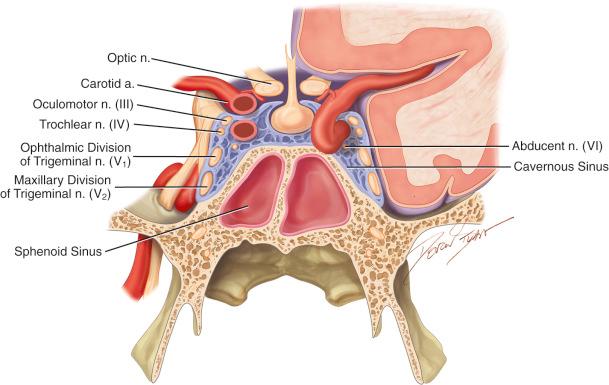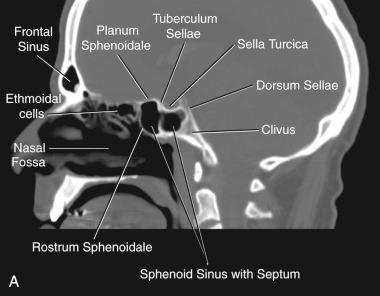Physical Address
304 North Cardinal St.
Dorchester Center, MA 02124
The parasellar region is an extensive area that includes the structures that surround the sella turcica. It includes laterally the dural walls of the cavernous sinus, which is bordered inferiorly by the sphenoid bone, superiorly with the diaphragma sella and the suprasellar subarachnoid spaces containing the optic nerves and chiasm, the circle of Willis, hypothalamus, tuber cinereum and anterior third ventricle ( Figure 33.1 ).

A heterogeneous group of lesions affects this region, usually involving the cranial nerves (CN) II–VI and the internal carotid artery (ICA). The most common tumors observed in this aforementioned region are: meningiomas, pituitary macroadenomas and trigeminal schwannomas. Other less commonly found lesions include chordoma, chondromas/chondrosarcomas, craniopharyngiomas, optic nerve gliomas, hemangiopericytoma, squamous cell carcinoma and adenocarcinoma.
Symptoms associated with lesions in this area include:
Headaches, nausea and vomiting: secondary to intracranial hypertension.
Visual deterioration: associated with compression of the optic apparatus.
CN dysfunction: compression of nerves III, IV, V and VI at the cavernous sinus (CS).
Hormonal deficits: medial portions of the lesion might compress the pituitary gland and pituitary stalk and be associated with hormonal dysfunctions such as diabetes insipidus, hypogonadism and hyperprolactinemia.
Head computed tomography (CT):
Bone windows are useful to determine extent of bony destruction or hyperostosis (i.e. in meningiomas).
Thin-cuts for the study of the sphenoid bone anatomy as well as the floor of the middle cranial fossa and petrous bone are helpful for surgical planning ( Figure 33.2A ).

Brain magnetic resonance imaging (MRI) ( Figure 33.2B–D ):
Signal characteristics are helpful in determining the tumor type along with the location and pattern of tumor extension, which can often determine the diagnosis preoperatively.
Contrast studies and flow voids can help reveal the relationship to surrounding structures.
MRI venography may be performed for evaluation of the regional venous anatomy and relation of tumor with the dural sinus at the skull base. It is especially useful in cases of large meningiomas at the parasellar region, which potentially invade the sphenoparietal sinus and modify the venous drainage at the middle fossa and temporal lobe.
Cerebral angiography or magnetic resonance angiography (MRA) ( Figure 33.2E ):
Can determine the vascularity of the tumor as well as its blood supply.
Can further demonstrate the involvement of the ICA and allow for embolization or balloon test occlusion if the carotid resection may be required.
Treatment options include conservative treatment, primary radiosurgery and surgery.
The aims of parasellar tumor surgery are:
Collection of tissue for pathological diagnosis.
Maximum safety tumor removal.
Preservation and restoration of neurological functions.
Indications for parasellar tumor surgery are:
Tumor progression or progressive hemorrhage or necrosis leading to:
Progressive visual loss from mass effect
Worsening cranial nerve dysfunction
Acute adrenal insufficiency and other hormonal abnormalities.
Benign lesions:
Meningiomas with progressive growth on serial imaging and progression of cranial nerve deficits should be considered for surgical treatment. They often originate outside of the cavernous sinus and are secondarily involving it. Those lesions are easier to resect completely than those originating from within the cavernous sinus.
Other benign tumors (trigeminal schwannomas, epidermoids, pituitary adenomas, cavernous hemangiomas) are easier to resect than meningiomas due to the fact that the carotid is more often displaced than encased in these cases and can usually be dissected free from the tumor.
Malignant lesions:
Chordoma/chondrosarcoma do not usually invade the structures in the cavernous sinus. A dissection plane between the tumor and the neurovascular structures may be easy to define allowing for straightforward dissection of the cranial nerves and ICA from the tumor even with bilateral cavernous sinus extension.
Other malignant tumors should be removed en bloc to increase survival if able. Complete resection must be feasible in order to justify radical surgery especially if cavernous ICA needs to be resected and replaced with a vein graft.
The appropriate choice for surgical approach is dictated mainly by the extent and character of involvement of adjacent structures. Some lesions are fairly well confined and only require straightforward dissection, other lesions require the combination of two or more standard approaches to gain access to the lesion and increase the possibilities of gross total resection.
Given many eloquent structures in this region, lesions that require surgical exposure and maneuvers that put particular structures at unnecessary risk and lengthen operating time are not recommended.
In recent years, radiosurgery has become an important option of treatment of cavernous sinus lesions, an adjunct to surgical procedure or a standalone treatment. It must be considered in the discussion of surgical treatment of those lesions, especially for lesions with invasion of the cavernous sinus and asymptomatic patients.
The surgical approach should be tailored according to the type and location of the tumor.
The parasellar region can be approached through either transcranial or transsphenoidal approaches.
The endoscopic approach to the cavernous sinus is best suited for pituitary adenomas with cavernous sinus invasion specifically in the anterolateral quadrant. Other types of tumor such as meningiomas and tough fibrotic tumors can be challenging to remove using endoscopic technique.
Feasible transcranial approaches to the parasellar region include:
Fronto-temporal approach — effective for exposing lesions confined to the cavernous sinus.
Anterolateral temporo-polar transcavernous approach — for posterior cavernous sinus lesions.
Orbitozygomatic approach — for tumors located high in the parasellar region and the interpeduncular fossa.
An endoscopic endonasal or endoscopic-assisted approach to the sella can be performed by a paraseptal, middle meatal or middle turbinectomy approach. The paraseptal approach is the least invasive and a basic workhorse among these three approaches.
Become a Clinical Tree membership for Full access and enjoy Unlimited articles
If you are a member. Log in here